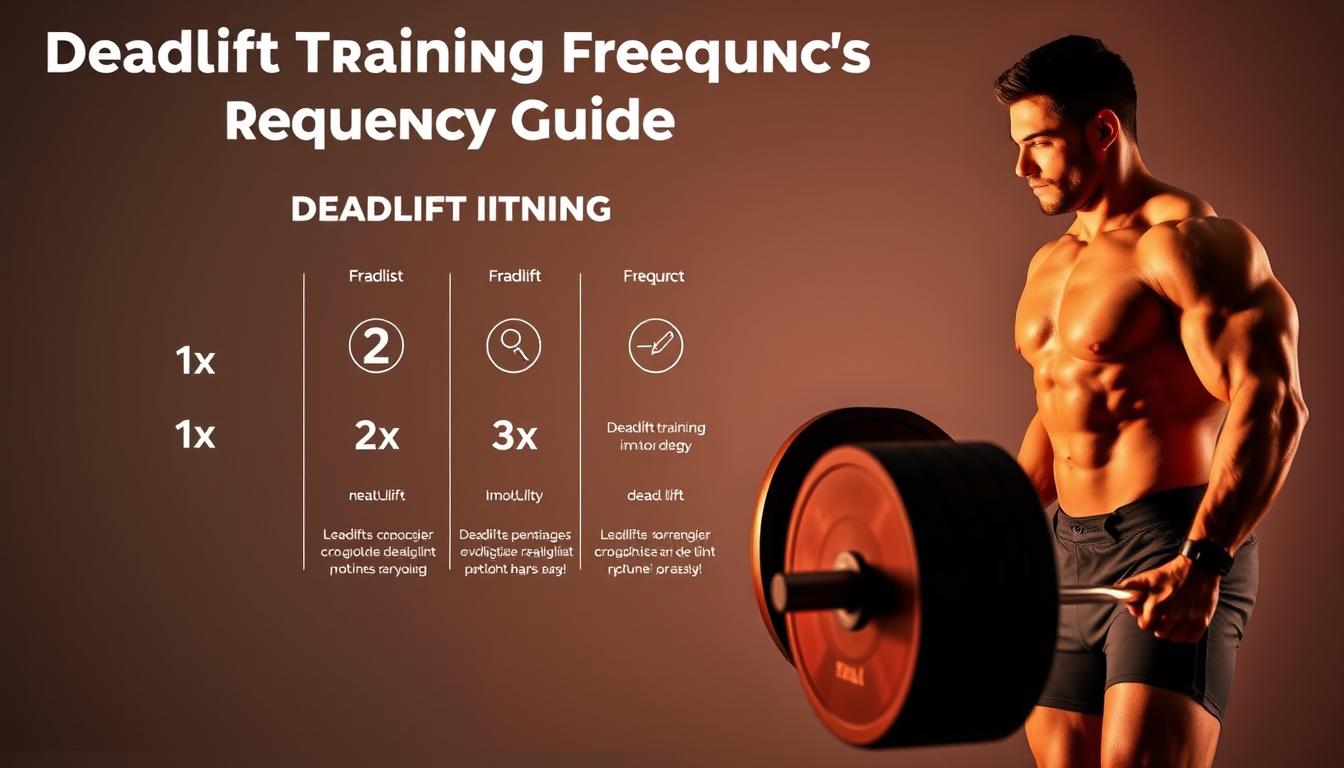How Often Should You Deadlift? Deadlift Frequencies & Times a Week, often do you deadlift

How Often Should You Deadlift? Deadlift Frequencies & Times a Week, often do you
Strength training fans love deadlifts for building strength all over the body. Knowing how often to deadlift can really help with muscle growth and fitness. People often ask how many times a week they should deadlift.
How often you deadlift depends on your experience, goals, and how well you recover. It's important to find a balance that pushes your muscles but doesn't hurt you.
Deadlifts work many muscles at once, making them a great exercise. Whether you're new or experienced, having a good deadlift plan can boost your strength and sports skills.
Key Takeaways
- Deadlift frequency varies based on individual fitness levels
- Proper recovery is key for muscle growth and avoiding injury
- Beginners should start with fewer deadlift sessions per week
- Advanced lifters can handle more frequent deadlift training
- Listen to your body and adjust deadlift frequencies as needed
Understanding Deadlift Basics and Its Impact on Training Frequency
Deadlifting is key in strength training, testing lifters in various sports. It demands precise technique and smart planning to progress safely.
Different Types of Deadlifts and Their Recovery Demands
Deadlift variations affect training intensity and recovery. Main types include:
- Conventional deadlift: Standard barbell lift with feet hip-width apart
- Sumo deadlift: Wider stance, shorter range of motion
- Romanian deadlift: Focuses on hamstring and posterior chain development
Each variation stresses different muscles, needing varied recovery times. A lifter's 1RM and goals set the right deadlift session frequency.
The Role of Proper Form in Training Frequency
Good form is essential for long-term deadlift training. Bad technique raises injury risk and hinders consistent training. Technique trumps weight every time.
Why Recovery Matters in Deadlift Programming
Recovery is more than just resting—it's muscle repair and strength growth. Lifters need to balance hard training with enough rest to avoid overtraining and boost deadlift progress.
Smart training is about working hard and recovering smarter.
How Often Should You Deadlift? Deadlift Frequencies & Times a Week
Finding the right deadlift frequency can greatly improve your strength. Whether you aim to deadlift once a week or more, knowing the best method is key. It affects muscle growth and your overall progress.

Deadlift Training Frequency Guide
Many lifters wonder about the best deadlift frequency. Some prefer deadlifting once a week, while others aim for more. The goal is to find a balance that fits your training goals and how well you recover.
- Beginners: Typically start with deadlifting once a week
- Intermediate lifters: May benefit from deadlift training twice a week
- Advanced athletes: Can explore higher frequency approaches
"The art of deadlift training is not about how often you dl, but how effectively you do it." - Strength Training Expert
The right deadlift frequency depends on several important factors. Some try deadlifting every day, but this is risky. Most coaches suggest a more careful approach to avoid overtraining and support muscle recovery.
To boost your deadlift, consider these tips:
- Watch how your body reacts to training
- Change frequency based on how you recover
- Focus on proper form and technique
The best deadlift frequency is different for everyone. Some do great with deads once a week, while others prefer more. Listen to your body, track your progress, and adjust your training as needed.
Factors Affecting Your Optimal Deadlift Frequency
Finding the best deadlift frequency isn't the same for everyone. Many important factors decide how often advanced lifters should do deadlifts in their workout routine.

Deadlift Training Frequency Factors
Your deadlift frequency depends on several key factors. These factors affect how well you train and how fast you recover.
Experience Level and Training History
Newbies usually need to deadlift less often than experienced lifters. Your past training is key in figuring out how often you can deadlift safely without overdoing it.
- Beginners: 1-2 times per week
- Intermediate lifters: 2-3 times per week
- Advanced lifters: Up to 3 times a week with careful programming
Goals and Training Program Structure
Your goals in strength training affect how often you deadlift. Powerlifters might deadlift more often than those aiming for general fitness.
- Strength development: Lower frequency, higher intensity
- Muscle hypertrophy: Moderate frequency with Romanian deadlifts
- Athletic performance: Varied frequency based on specific goals
Recovery Capacity and Lifestyle Factors
How well you recover from workouts affects your deadlift frequency. Sleep, diet, stress, and physical health all play a role in how often you can deadlift effectively.
Increasing deadlift frequency needs careful watching of your body's response. It's important to avoid overtraining risks.
Designing Your Weekly Deadlift Schedule for Maximum Progress
Creating a good deadlift program needs careful planning. It's about getting stronger and building muscle. Powerlifters and strength athletes know it's not just about lifting heavy. It's about smart training.
When making a weekly deadlift plan, think about these things:
- Your current training history
- How well you recover
- What you want to achieve
- How good you are at different deadlift styles
A good deadlift program uses different types to work your back and avoid getting stuck. Here's a weekly plan for different levels:
| Experience Level | Deadlift Frequency | Variation Focus |
| Beginner | 1-2 times/week | Conventional deadlift |
| Intermediate | 2-3 times/week | Rack pull + Sumo deadlift |
| Advanced | 3-4 times/week | Mixed variation training |
Keeping good form is key. Start slow and watch how your body reacts. Right technique helps avoid injuries and keeps you getting stronger.
"Smart training beats hard training every time." - Strength Training Principle
Pay attention to your body, track your progress, and change your plan if needed. The best program fits your body and goals.
Conclusion
Understanding deadlift frequency is complex, based on sports science and personal needs. Athletes need to know that the best deadlift plan changes with age, recovery, and strength goals. Different deadlift methods, like trap bar and tempo deadlifts, need special thought when planning workouts.
Good strength training needs a smart plan for volume and intensity. Lifters should do squats and deadlifts 1-2 times a week, focusing on form and listening to their body. Creating a program that balances training with rest is vital for progress and avoiding injuries.
Finding the right deadlift frequency is a trial-and-error process. Athletes must be ready to change their sets and intensity based on how they respond. Whether you're new or experienced, keeping proper technique, watching your body, and being patient are key.
By being flexible and informed in deadlift training, athletes can reach their full strength. Remember, each training cycle is a chance to learn and improve your strength plan.
How Often Should You Deadlift: Deadlift Frequencies Explained
How Many Times a Week Should You Deadlift?
The frequency for deadlifts largely depends on your training history and goals. For beginners, deadlifting once or twice a week may be sufficient to build foundational strength. More experienced lifters often incorporate deadlifts into their routine three times a week to maximize strength gains and improve their overall deadlift performance.
What Factors to Consider When Determining Deadlift Frequency?
Several factors influence how often you should deadlift, including your training age, recovery ability, and overall program structure. Beginners may need more recovery time, while advanced lifters can handle higher deadlift frequencies due to their adapted muscular endurance and strength.
Should You Deadlift Every Day?
Deadlifting every day is generally not recommended due to the high risk of injury and the need for recovery. However, you can incorporate lighter deadlift variations or accessory exercises targeting similar muscle groups to maintain movement patterns without overloading your central nervous system.
How Can You Increase Your Deadlift?
To increase your deadlift, focus on improving your technique, adjusting your training volume, and ensuring proper recovery. Implementing different deadlift variations can also help target specific muscle groups and enhance your overall strength.
What Are Some Types of Deadlifts to Include in Your Training?
There are several types of deadlifts you can include in your training program, such as conventional deadlifts, sumo deadlifts, and trap bar deadlifts. Each variation targets different muscle groups and can help increase your deadlift frequency by adding variety to your workouts.
What Is the Recommended Deadlift Training Volume?
The recommended training volume for deadlifts typically involves multiple sets of 5 to 8 reps. This range allows for adequate strength development without excessive fatigue, making it easier to maintain good technique and reduce the risk of injury.
How Does Squatting Affect Your Deadlift Strength?
Squatting can significantly improve your deadlift strength, as both movements engage similar muscle groups, particularly the back muscles and legs. Incorporating squats into your training program can enhance your overall strength and contribute to better deadlift performance.
What Is the Best Frequency for Deadlifts to Maximize Strength Gains?
The best frequency for deadlifts to maximize strength gains varies among individuals. Generally, training deadlifts two to three times a week allows for sufficient volume and recovery. Adjustments should be made based on your personal goals and the intensity and volume of your workouts.
Thanks for reading!




